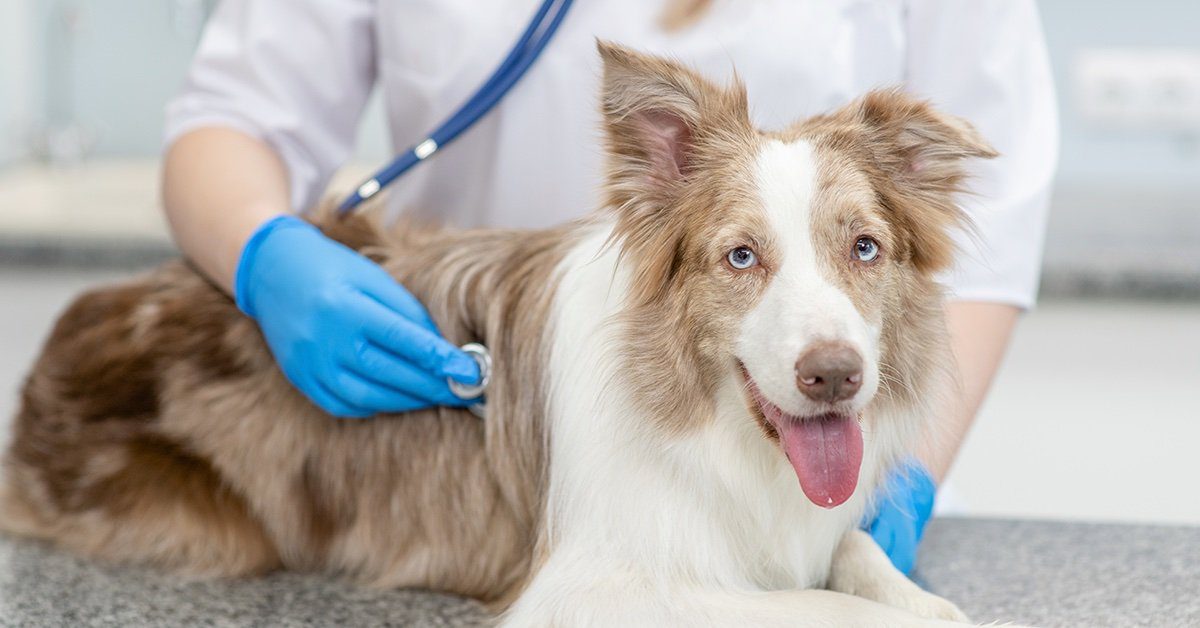Preventative health is just as important for our canine companions as it is for us. According to the American Animal Hospital Association (AAHA), preventative care helps us give more pets a greater chance at longer and better lives – which means more snuggles, more walks, and more games of fetch!
Keeping your dog in tip-top shape starts with regular trips to the veterinarian, which may have you wondering: how often should I take my dog to the vet?
Generally, your dog should have a wellness check-up at least once a year. However, the number of times you should take your dog to the vet can vary based on your dog’s age, lifestyle, and existing health conditions, among other factors.
Below, we’ll walk you through a breakdown of how often you may need to take your dog to the vet based on their age.
Puppy vet visits
It’s very likely that you’ll visit the vet’s office more times during your new puppy’s first year of life than any other time.
One of the most important things you can do for your dog’s health as a puppy is to make sure to take them in for all their puppy visits. During these visits, you will learn valuable information about health, how your puppy is growing, nutrition, parasite and disease prevention, behavior, and training, and socialization, all of which are critical components of health and wellness.
One of the ways to get your puppy started out on the right foot is to work with your veterinarian to make sure they have all their recommended vaccines. Vaccines help develop your pup’s immune system and prevent the spread of disease.
The AAHA recommends five core vaccines for puppies, and the regiment generally starts when puppies are six to eight weeks old. Puppies begin with a combination vaccine that protects against canine distemper virus, parvovirus, and adenovirus-2. This combination vaccine may or may not include protection against parainfluenza virus.
You’ll need to bring your puppy to the vet’s office every three or four weeks for booster shots of this vaccine until they’re about 16 weeks old. Then, when your pup is no younger than three months old, they’ll receive a rabies vaccine.
Depending on your puppy’s health risks, lifestyle, and your location, your vet may also recommend non-core vaccines, such as those that protect against the canine flu, lyme disease, or bordetella. Check out our puppy vaccine schedule to keep track!
During these wellness visits, your vet will also check on your furry friend’s growth and general health. Now is the time to ask your vet about nutrition, exercise, training, and socialization recommendations as well.
During these visits, your vet may also recommend and/or discuss other common procedures for puppies, such as deworming, heartworm testing and prevention, and flea and tick prevention.
After your puppy’s vaccination series is complete, they will return to the vet for spaying or neutering, if you choose to have that done. Depending on your pup’s sex, breed, and size, your veterinarian can recommend the best time for the procedure – but you can expect it to be anywhere from six to 24 months old.
Pet Pro Tip: Illnesses won’t wait to happen. You shouldn’t wait to enroll in pet insurance. From common parasite infections, to costly hereditary illnesses, pet insurance is worth it and can cover crucial eligible treatment your pet may need for their unexpected accidents and illnesses. Find out how pet insurance works, what pet insurance covers, and choose a plan today.
Adult dog vet visits
Adult dogs – ages one to seven – typically need annual check-ups. If your dog is healthy, doesn’t need any booster shots on a more frequent schedule, and doesn’t have any problems that need to be addressed, the annual wellness exam usually suffices through their adult years.
The most important part of your dog’s annual check-up is the physical exam. Your vet will conduct a complete tail to nose exam, including taking vitals, checking their weight, checking for any lumps or bumps, listening to their heart and lungs, examining their dental health and joint health and bone health. If there is something of concern, your vet may recommend tests or treatment as necessary, and your vet will ask if you have any concerns you’d like to discuss as well. This is an excellent time to pick your vet’s brain about any questions you have, so make sure to write your questions down ahead of time so you don’t forget anything.
Most vets recommend running a fecal test during the annual visit to check for intestinal parasites. Intestinal parasites, including hookworms, whipworms, and roundworms, can often go undetected and are contagious to humans and other pets, which is why it is a good idea to have your doggo’s poop checked once a year for creepy crawlies, so don’t forget to bring a fresh fecal sample with you to the visit.
During this yearly check-up, your vet will also administer any booster shots your dog needs. Your dog will need a booster of the combination vaccine one year after they’ve completed the puppy series and then typically every three years after that. The rabies vaccine is given every one or three years, depending on the label of vaccine your dog receives initially.
If your dog needs any additional vaccines, they may receive them at annual vet visits as well. Dogs that attend daycare or boarding facilities, for example, may be required to provide proof of the kennel cough vaccine. Some facilities require this vaccine every six months, in which case, your dog will need a semi-annual trip to the vet’s office. Your veterinarian can help you decide which, if any, other vaccinations will be beneficial for your pet’s health based on risk level, location, and lifestyle.
In addition to vaccines, your vet will discuss parasite prevention, including heartworm, flea, and tick prevention. It is recommended for most dogs to be tested for heartworm disease once a year, even if they receive heartworm preventative.
If your dog has underlying health issues, you may need to visit the vet more frequently than once per year for necessary testing or treatment.
Senior dog vet visits
Senior dogs (those eight years and older) often benefit from visiting the vet’s office for check-ups twice a year. Older dogs can be prone to illness and injury, so seeing your vet semi-annually can help address any issues before they occur.
During these wellness visits, your vet will perform a complete physical exam, paying special attention to areas that typically affect older dogs. For example, your vet will look closely at your dog’s teeth and recommend additional dental care tips. They’ll also examine your dog’s weight and keep an eye out for mobility issues or joint pain. Your veterinarian may also recommend running annual blood and urine tests to check internal organ function.
Your veterinarian may also recommend vaccine boosters or parasite control during senior dog visits, depending on your dog’s overall health and disease risk.
As your dog continues to age, they may require more frequent trips to the vet, depending on their health and any illnesses or problems that may develop. This is why it pays to have health insurance if you have an older pup!
When to take your dog to the vet immediately
Hopefully, you’ll only have to visit the vet’s office for your dog’s regular check-ups. Sometimes, however, emergencies occur, and knowing what to look for can help prepare you to act quickly in those situations.
According to the American Veterinary Medical Association (AVMA), here are some examples of pet health emergencies that need immediate care:
- Your dog seems to have a broken bone or can’t move their legs.
- Your dog seems to be in severe pain.
- Your dog is seizing.
- Your dog is unconscious and won’t wake up.
- Your dog has an injury to their eye.
- You think or know your dog has eaten something poisonous (e.g. antifreeze, chocolate, rat poison).
- Your dog has severe vomiting or diarrhea – or refuses to drink for 24 hours or more.
- Your dog seems to be choking or is having trouble breathing.
- Your dog is bleeding and it won’t stop – or has blood in their urine, is coughing up blood, etc.
- Your dog has been hit by a car, a large object, or attacked by another animal.
Overall, if you’re concerned about your dog’s health, the AVMA recommends at a minimum, you give your veterinarian a call. And don’t forget, you know your dog best – so if you think something’s wrong or out of character, it’s probably worth getting it checked out.
Planning for a healthy future
From the start of your furry friend’s life, you’ll be making regular trips to the vet’s office, so finding a veterinarian that you like and trust can make your puppy health care journey that much easier. Plus, the right veterinarian will be a great resource for all of your dog health-related questions – from puppyhood through seniorhood.
Having pet insurance can help take the financial stress out of both routine and surprise vet visits. From medications to unexpected surgeries, Pumpkin’s dog insurance plans can help you pay for the best care possible – now, and furever.
*Pumpkin Pet Insurance policies do not cover pre-existing conditions. Waiting periods, annual deductible, co-insurance, benefit limits and exclusions may apply. For full terms, visit pumpkin.care/insurancepolicy. Products, discounts, and rates may vary and are subject to change. Pumpkin Insurance Services Inc. (Pumpkin) (NPN#19084749) is a licensed insurance agency, not an insurer. Insurance is underwritten by United States Fire Insurance Company (NAIC #21113. Morristown, NJ), a Crum & Forster Company and produced by Pumpkin. Pumpkin receives compensation based on the premiums for the insurance policies it sells. For more details visit pumpkin.care/underwriting-information and pumpkin.care/insurance-licenses.




